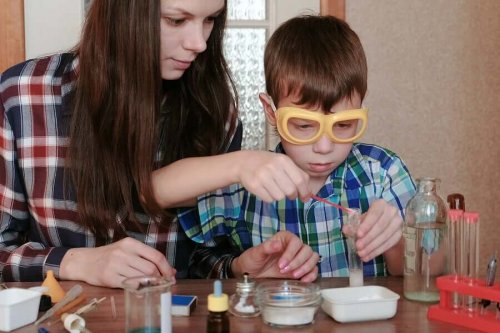3 Ideas to Teach Children to Enjoy Science


Written and verified by the psychologist María Alejandra Castro Arbeláez
With some simple experiments, it’s indeed possible to teach children to enjoy science. However, there’s no need for a laboratory or a strategy that’s too elaborate to carry out. In fact, there are many experiments that require few materials, yet we should never neglect security measures.
As children advance in their schooling, it’s normal for them to feel interested in practical activities that are carried out in class. Their curiosity leads them to express a great fascination with scientific processes and they’re often willing to take part in conducting experiments.
From that point of view, it’s necessary to take advantage of this curiosity and guide it in order to develop a true interest in learning and gaining knowledge. Who said that science – or any other subject – had to be tedious? Keep reading to find out how to enjoy science with children.
Teaching children to enjoy science: Preliminary aspects
It would be ideal to regularly spend family time together doing home experiments when the children are between 3 and 8 years old. This is the stage where they have more fun with it (and it’s also the most appropriate stage to “hook” them to the subject).
Although it may not seem like it, conducting experiments at home can help lay down the foundations and basic concepts, so that children understand theories better in the classroom.
All experiments should be performed as a family, under supervision. Even if it seems like children can handle the situation, due to safety measures, we should always take precautions. Keep in mind that it’s not a game, even if it seems like one.
Children’s first encounter with science must be consistent with previous and meaningful ideas, based on everyday experiences so as not to generate a negative attitude towards them, due to their decontextualized appearance.
– W. Harlen –
Enjoy science with children: capillary absorption

Step by step
- Get some white flowers and cut them diagonally. To speed up the effect of the experiment, the stems must be short.
- Add approximately 30 drops of food coloring to a cup of warm water and put the flower stalks in it.
- Let the flowers rest for a few minutes until the petals begin to change color. The longer they remain submerged, the stronger the coloration will be.
If you check the stems, you’ll see how the dye ink travels through the stem and petals. This is the capillary action and the ability of the water to travel through small surfaces and transport substances in the plant.
Growing a bean
Step by step
- You’ll need a glass bowl, a bean, a napkin or a large piece of cotton, and water.
- Put some water in the bowl.
- Fold the napkin or piece of cotton and put it inside the jar. It must be well kneaded and moist.
- Put the bean in the jar, resting on the napkin or cotton and then, sprinkle some water on the seed daily.
As the days go by, the bean will start to take root. This is a very simple way to explain to your children the germination process of the plants we consume at home.
Surface tension explained with milk

- You’ll need a transparent dish or bowl, high-fat milk, food coloring of different colors, liquid soap, and a cotton swab. You can also use a toothpick instead of a swab.
- Pour a layer of milk of about 1 centimeter deep.
- Add small drops of each of the dyes in the bowl with milk. You can use different colors and quantities and spread them apart or close together.
- The next step is to soak the swab with a little soap and put it in the milk. When you do this, you’ll see how the dye drops start displacing and moving away from the liquid soap.
In this experiment, you can see how soap reduces the surface tension of milk fat. That’s why colors move and combine.

Keep in mind
- In order for children to enjoy science (including math), it’s necessary to present the information in a playful way.
- Try to adapt the activities to the age and interests of your children. That is, if they like sports or art, relate your teachings to these areas so that they can assimilate the information more easily.
- Visits to museums encourage interest and are a way to enjoy science. Make the most of them!
- The abstract repetition of theories and definitions without any practice doesn’t allow children to assimilate the information properly.
- When children discover that they have an application in our daily life, they become even more interested in learning. Be sure to point them out on a daily basis, where you can find the different expressions of science.
Nowadays, teaching children to enjoy science is very easy, given that there are lots of resources available. Take advantage of the children’s enthusiasm to make your day-to-day more fun!
With some simple experiments, it’s indeed possible to teach children to enjoy science. However, there’s no need for a laboratory or a strategy that’s too elaborate to carry out. In fact, there are many experiments that require few materials, yet we should never neglect security measures.
As children advance in their schooling, it’s normal for them to feel interested in practical activities that are carried out in class. Their curiosity leads them to express a great fascination with scientific processes and they’re often willing to take part in conducting experiments.
From that point of view, it’s necessary to take advantage of this curiosity and guide it in order to develop a true interest in learning and gaining knowledge. Who said that science – or any other subject – had to be tedious? Keep reading to find out how to enjoy science with children.
Teaching children to enjoy science: Preliminary aspects
It would be ideal to regularly spend family time together doing home experiments when the children are between 3 and 8 years old. This is the stage where they have more fun with it (and it’s also the most appropriate stage to “hook” them to the subject).
Although it may not seem like it, conducting experiments at home can help lay down the foundations and basic concepts, so that children understand theories better in the classroom.
All experiments should be performed as a family, under supervision. Even if it seems like children can handle the situation, due to safety measures, we should always take precautions. Keep in mind that it’s not a game, even if it seems like one.
Children’s first encounter with science must be consistent with previous and meaningful ideas, based on everyday experiences so as not to generate a negative attitude towards them, due to their decontextualized appearance.
– W. Harlen –
Enjoy science with children: capillary absorption

Step by step
- Get some white flowers and cut them diagonally. To speed up the effect of the experiment, the stems must be short.
- Add approximately 30 drops of food coloring to a cup of warm water and put the flower stalks in it.
- Let the flowers rest for a few minutes until the petals begin to change color. The longer they remain submerged, the stronger the coloration will be.
If you check the stems, you’ll see how the dye ink travels through the stem and petals. This is the capillary action and the ability of the water to travel through small surfaces and transport substances in the plant.
Growing a bean
Step by step
- You’ll need a glass bowl, a bean, a napkin or a large piece of cotton, and water.
- Put some water in the bowl.
- Fold the napkin or piece of cotton and put it inside the jar. It must be well kneaded and moist.
- Put the bean in the jar, resting on the napkin or cotton and then, sprinkle some water on the seed daily.
As the days go by, the bean will start to take root. This is a very simple way to explain to your children the germination process of the plants we consume at home.
Surface tension explained with milk

- You’ll need a transparent dish or bowl, high-fat milk, food coloring of different colors, liquid soap, and a cotton swab. You can also use a toothpick instead of a swab.
- Pour a layer of milk of about 1 centimeter deep.
- Add small drops of each of the dyes in the bowl with milk. You can use different colors and quantities and spread them apart or close together.
- The next step is to soak the swab with a little soap and put it in the milk. When you do this, you’ll see how the dye drops start displacing and moving away from the liquid soap.
In this experiment, you can see how soap reduces the surface tension of milk fat. That’s why colors move and combine.

Keep in mind
- In order for children to enjoy science (including math), it’s necessary to present the information in a playful way.
- Try to adapt the activities to the age and interests of your children. That is, if they like sports or art, relate your teachings to these areas so that they can assimilate the information more easily.
- Visits to museums encourage interest and are a way to enjoy science. Make the most of them!
- The abstract repetition of theories and definitions without any practice doesn’t allow children to assimilate the information properly.
- When children discover that they have an application in our daily life, they become even more interested in learning. Be sure to point them out on a daily basis, where you can find the different expressions of science.
Nowadays, teaching children to enjoy science is very easy, given that there are lots of resources available. Take advantage of the children’s enthusiasm to make your day-to-day more fun!
All cited sources were thoroughly reviewed by our team to ensure their quality, reliability, currency, and validity. The bibliography of this article was considered reliable and of academic or scientific accuracy.
- Harlen, W. (2000). Enseñanza y aprendizaje de las ciencias. España. Ediciones Morata.
- Tenenbaum HR and Leaper C. 2003. Parent-child conversations about science: the socialization of gender inequities? Dev Psychol. 39(1):34-47.
This text is provided for informational purposes only and does not replace consultation with a professional. If in doubt, consult your specialist.








